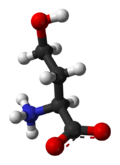Chemistry:Homoserine

| |

| |
| Names | |
|---|---|
| IUPAC name
(S)-2-Amino-4-hydroxybutanoic acid
| |
| Identifiers | |
3D model (JSmol)
|
|
| ChEBI | |
| ChEMBL | |
| ChemSpider | |
| EC Number |
|
PubChem CID
|
|
| UNII | |
| |
| |
| Properties | |
| C4H9NO3 | |
| Molar mass | 119.12 g/mol |
| Melting point | 203 °C (decomposes) |
Except where otherwise noted, data are given for materials in their standard state (at 25 °C [77 °F], 100 kPa). | |
| Infobox references | |
Homoserine (also called isothreonine) is an α-amino acid with the chemical formula HO2CCH(NH2)CH2CH2OH. L-Homoserine is not one of the common amino acids encoded by DNA. It differs from the proteinogenic amino acid serine by insertion of an additional -CH2- unit into the backbone. Homoserine, or its lactone form, is the product of a cyanogen bromide cleavage of a peptide by degradation of methionine.
Homoserine is an intermediate in the biosynthesis of three essential amino acids: methionine, threonine (an isomer of homoserine), and isoleucine.[1] Its complete biosynthetic pathway includes glycolysis, the tricarboxylic acid (TCA) or citric acid cycle (Krebs cycle), and the aspartate metabolic pathway. It forms by two reductions of aspartic acid via the intermediacy of aspartate semialdehyde.[2] Specifically, the enzyme homoserine dehydrogenase, in association with NADPH, catalyzes a reversible reaction that interconverts L-aspartate-4-semialdehyde to L-homoserine. Then, two other enzymes, homoserine kinase and homoserine O-succinyltransferase use homoserine as a substrate and produce phosphohomoserine and O-succinyl homoserine respectively.[3]
Applications
Commercially, homoserine can serve as precursor to the synthesis of isobutanol and 1,4-butanediol.[4] Purified homoserine is used in enzyme structural studies.[5] Also, homoserine has played important roles in studies to elucidate peptide synthesis and synthesis of proteoglycan glycopeptides.[6] Bacterial cell lines can make copious amounts of this amino acid.[3][4]
Biosynthesis
Homoserine is produced from aspartate via aspartate-4-semialdehyde, which is produced from β-phosphoaspartate. By the action of homoserine dehydrogenases, the semialdehyde is converted to homoserine.[7]
L-Homoserine is substrate for homoserine kinase, yielding phosphohomoserine (homoserine-phosphate), which is converted to by threonine synthase to yield L-threonine.
Homoserine is converted to O-succinyl homoserine by homoserine O-succinyltransferase, a precursor to L-methionine.[8]
Homoserine allosterically inhibits aspartate kinase and glutamate dehydrogenase.[3] Glutamate dehydrogenase reversibly converts glutamate to α-ketoglutarate and α-ketoglutarate coverts to oxaloacetate through the citric cycle. Threonine acts as another allosteric inhibitor of aspartate kinase and homoserine dehydrogenase, but it is a competitive inhibitor of homoserine kinase.[8]
References
- ↑ "Studies on the Synthesis of l -Amino Acids: Part III. A Synthesis of l -Homoserine from l -Aspartic Acid" (in en). Agricultural and Biological Chemistry 25 (9): 678–679. September 1961. doi:10.1080/00021369.1961.10857862. ISSN 0002-1369. https://academic.oup.com/bbb/article/25/9/678-679/5976039.
- ↑ Berg, J. M.; Stryer, L. et al. (2002), Biochemistry. W.H. Freeman. ISBN:0-7167-4684-0
- ↑ 3.0 3.1 3.2 "Multiplex Design of the Metabolic Network for Production of l-Homoserine in Escherichia coli". Applied and Environmental Microbiology 86 (20). October 2020. doi:10.1128/AEM.01477-20. PMID 32801175. Bibcode: 2020ApEnM..86E1477L.
- ↑ 4.0 4.1 "Metabolic engineering of E. coli for the production of O-succinyl-l-homoserine with high yield". 3 Biotech 8 (7): 310. July 2018. doi:10.1007/s13205-018-1332-x. PMID 30002999.
- ↑ "The crystal structure of homoserine dehydrogenase complexed with l-homoserine and NADPH in a closed form". Journal of Biochemistry 165 (2): 185–195. February 2019. doi:10.1093/jb/mvy094. PMID 30423116.
- ↑ "Homoserine as an Aspartic Acid Precursor for Synthesis of Proteoglycan Glycopeptide Containing Aspartic Acid and a Sulfated Glycan Chain". The Journal of Organic Chemistry 81 (23): 12052–12059. December 2016. doi:10.1021/acs.joc.6b02441. PMID 27809505.
- ↑ Viola, Ronald E. (2001). "The Central Enzymes of the Aspartate Family of Amino Acid Biosynthesis". Accounts of Chemical Research 34 (5): 339–349. doi:10.1021/ar000057q. PMID 11352712.
- ↑ 8.0 8.1 "Reduction of Feedback Inhibition in Homoserine Kinase (ThrB) of Corynebacterium glutamicum Enhances l-Threonine Biosynthesis". ACS Omega 3 (1): 1178–1186. January 2018. doi:10.1021/acsomega.7b01597. PMID 30023797.
 |


